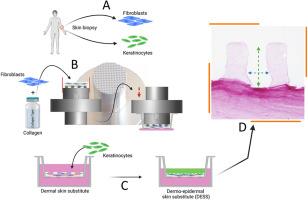Simple method for the production of rete ridges in human dermo-epidermal skin substitutes
IF 3.5
3区 生物学
Q3 CELL BIOLOGY
引用次数: 0
Abstract
The engineering of autologous dermo-epidermal skin substitutes aims to replicate the functional and structural properties of normal human skin for treating severe burns, trauma, congenital giant nevi, and necrosis-inducing diseases. We established autologous dermo-epidermal skin analogues, the quality of which is presently being assessed in phase II and III trials.
A primary challenge we are facing involves the incorporation of undulating epidermal extensions, known as rete ridges, into the dermis. This integration enhances mechanical stiffness at the dermal-epidermal junction and extend the capillary-epidermal interface, thereby facilitating wound healing.
To address this challenge, we employed a refined version of our laboratory's established protocol, utilizing simpler technologies. We specifically used a hydrogel formulated from pure type I collagen mixed with fibroblasts, which was then subjected to plastic compression to ensure mechanical stability. To introduce dermal papillae, we modified the surface of the compression piston to create a 'wavy' texture, mimicking natural skin. This piston acts as a mould during both the gelation and plastic compression phases of the hydrogel. As a result, we successfully developed rete ridges with the expected dimensions, but their stability after keratinocyte seeding remains an issue.
In summary, while operational simplicity and avoidance of potentially toxic crosslinkers, provides a safe and easily adoptable route to replicating the natural structure of the rete ridges, we still face challenges in controlling ridge dimensions and maintaining the integrity of the dermal-epidermal junction structure.

制备人真皮-表皮皮肤代用品中网状嵴的简易方法
自体真皮-表皮皮肤替代物的工程旨在复制正常人类皮肤的功能和结构特性,用于治疗严重烧伤、创伤、先天性巨痣和坏死诱导疾病。我们建立了自体真皮-表皮皮肤类似物,其质量目前正在II期和III期试验中进行评估。我们面临的一个主要挑战是将起伏的表皮延伸,即所谓的网状脊,整合到真皮层中。这种整合增强了真皮-表皮交界处的机械刚度,并扩展了毛细血管-表皮界面,从而促进了伤口愈合。为了应对这一挑战,我们采用了实验室既定协议的改进版本,利用了更简单的技术。我们特别使用了一种由纯I型胶原蛋白与成纤维细胞混合而成的水凝胶,然后对其进行塑料压缩以确保机械稳定性。为了引入真皮乳头,我们修改了压缩活塞的表面,以创造一个“波浪”纹理,模仿自然皮肤。这个活塞在水凝胶的凝胶化和塑性压缩阶段都起着模具的作用。因此,我们成功地开发了具有预期尺寸的网状嵴,但其在角质细胞播种后的稳定性仍然是一个问题。总之,虽然操作简单和避免潜在毒性交联剂,为复制远端脊的自然结构提供了一种安全且易于采用的途径,但我们仍然面临着控制脊尺寸和保持真皮-表皮连接结构完整性的挑战。
本文章由计算机程序翻译,如有差异,请以英文原文为准。
求助全文
约1分钟内获得全文
求助全文
来源期刊

Experimental cell research
医学-细胞生物学
CiteScore
7.20
自引率
0.00%
发文量
295
审稿时长
30 days
期刊介绍:
Our scope includes but is not limited to areas such as: Chromosome biology; Chromatin and epigenetics; DNA repair; Gene regulation; Nuclear import-export; RNA processing; Non-coding RNAs; Organelle biology; The cytoskeleton; Intracellular trafficking; Cell-cell and cell-matrix interactions; Cell motility and migration; Cell proliferation; Cellular differentiation; Signal transduction; Programmed cell death.
 求助内容:
求助内容: 应助结果提醒方式:
应助结果提醒方式:


